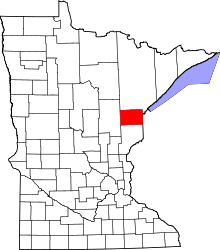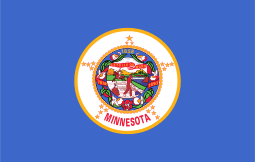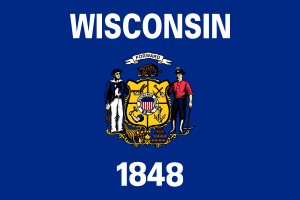Carlton, Minnesota
| Carlton, Minnesota | |
|---|---|
| City | |
|
Carlton County Courthouse in Carlton | |
 Location of the city of Carlton within Carlton County, Minnesota | |
| Coordinates: 46°39′50″N 92°25′30″W / 46.66389°N 92.42500°W | |
| Country | United States |
| State | Minnesota |
| County | Carlton |
| Area[1] | |
| • Total | 2.27 sq mi (5.88 km2) |
| • Land | 2.06 sq mi (5.34 km2) |
| • Water | 0.21 sq mi (0.54 km2) |
| Elevation | 1,083 ft (330 m) |
| Population (2010)[2] | |
| • Total | 862 |
| • Estimate (2012[3]) | 854 |
| • Density | 418.4/sq mi (161.5/km2) |
| Time zone | Central (CST) (UTC-6) |
| • Summer (DST) | CDT (UTC-5) |
| ZIP code | 55718 |
| Area code(s) | 218 |
| FIPS code | 27-10018[4] |
| GNIS feature ID | 0640914[5] |
| Website | www.cityofcarlton.com |
Carlton is a city in Carlton County, Minnesota, United States. The population was 862 at the 2010 census.[6] It is the county seat of Carlton County.[7]
Minnesota State Highways 45 and 210; and County Roads 1 and 3 are four of the main routes in the community. The city of Carlton is located five miles south of the city of Cloquet; and 21 miles southwest of the city of Duluth.
History
In 1870, the Northern Pacific Railroad decided to finish a stretch of track that would link Duluth to St. Paul. Temporary shacks were erected for the workmen at the place that was soon known as "Northern Pacific Junction". In 1881, this settlement was incorporated as "Carlton". It takes its name from former State Senator Reuben Carlton.[8]
Thomson merged with Carlton in 2015.[9]
Geography
According to the United States Census Bureau, the city has a total area of 2.27 square miles (5.88 km2), of which, 2.06 square miles (5.34 km2) is land and 0.21 square miles (0.54 km2) is water.[1]
The Saint Louis River is nearby. Carlton is the home of Black Bear Casino Resort.
The Thomson Reservoir and Dam, and Jay Cooke State Park are also nearby; and the Willard Munger Bicycle Trail runs through the city of Carlton.
Demographics
| Historical population | |||
|---|---|---|---|
| Census | Pop. | %± | |
| 1890 | 612 | — | |
| 1900 | 449 | −26.6% | |
| 1910 | 597 | 33.0% | |
| 1920 | 700 | 17.3% | |
| 1930 | 687 | −1.9% | |
| 1940 | 700 | 1.9% | |
| 1950 | 652 | −6.9% | |
| 1960 | 862 | 32.2% | |
| 1970 | 884 | 2.6% | |
| 1980 | 862 | −2.5% | |
| 1990 | 923 | 7.1% | |
| 2000 | 810 | −12.2% | |
| 2010 | 862 | 6.4% | |
| Est. 2015 | 1,048 | [10] | 21.6% |
| U.S. Decennial Census | |||
2010 census
As of the census[2] of 2010, there were 862 people, 337 households, and 175 families residing in the city. The population density was 418.4 inhabitants per square mile (161.5/km2). There were 355 housing units at an average density of 172.3 per square mile (66.5/km2). The racial makeup of the city was 92.0% White, 0.5% African American, 4.3% Native American, 0.3% Asian, 0.5% from other races, and 2.4% from two or more races. Hispanic or Latino of any race were 1.5% of the population.
There were 337 households of which 24.3% had children under the age of 18 living with them, 35.6% were married couples living together, 11.3% had a female householder with no husband present, 5.0% had a male householder with no wife present, and 48.1% were non-families. 43.3% of all households were made up of individuals and 25.8% had someone living alone who was 65 years of age or older. The average household size was 2.09 and the average family size was 2.82.
The median age in the city was 44.2 years. 18% of residents were under the age of 18; 7.6% were between the ages of 18 and 24; 25.2% were from 25 to 44; 21.4% were from 45 to 64; and 27.7% were 65 years of age or older. The gender makeup of the city was 44.8% male and 55.2% female.
2000 census
As of the census[4] of 2000, there were 810 people, 306 households, and 179 families residing in the city. The population density was 393.8 people per square mile (151.8/km²). There were 325 housing units at an average density of 158.0 per square mile (60.9/km²). The racial makeup of the city was 95.19% White, 3.46% Native American, 0.12% from other races, and 1.23% from two or more races. Hispanic or Latino of any race were 0.62% of the population. 25.1% were of German, 15.3% Norwegian, 12.4% Finnish, 9.8% Swedish, 6.0% Polish and 5.5% Irish ancestry according to Census 2000.
There were 306 households out of which 26.2% had children under the age of 18 living with them, 43.1% were married couples living together, 11.1% had a female householder with no husband present, and 41.5% were non-families. 37.3% of all households were made up of individuals and 23.5% had someone living alone who was 65 years of age or older. The average household size was 2.22 and the average family size was 2.93.
In the city the population was spread out with 20.5% under the age of 18, 7.4% from 18 to 24, 24.2% from 25 to 44, 19.8% from 45 to 64, and 28.1% who were 65 years of age or older. The median age was 44 years. For every 100 females there were 93.3 males. For every 100 females age 18 and over, there were 89.4 males.
The median income for a household in the city was $31,477, and the median income for a family was $44,792. Males had a median income of $32,614 versus $21,167 for females. The per capita income for the city was $15,586. About 6.3% of families and 9.7% of the population were below the poverty line, including 13.1% of those under age 18 and 8.8% of those age 65 or over.
Festival
Carlton Daze is the name of the city of Carlton's celebration that is usually held annually in late July.
References
- 1 2 "US Gazetteer files 2010". United States Census Bureau. Archived from the original on 2012-07-14. Retrieved 2012-11-13.
- 1 2 "American FactFinder". United States Census Bureau. Retrieved 2012-11-13.
- ↑ "Population Estimates". United States Census Bureau. Archived from the original on 2013-06-17. Retrieved 2013-05-28.
- 1 2 "American FactFinder". United States Census Bureau. Archived from the original on 2013-09-11. Retrieved 2008-01-31.
- ↑ "US Board on Geographic Names". United States Geological Survey. 2007-10-25. Retrieved 2008-01-31.
- ↑ "2010 Census Redistricting Data (Public Law 94-171) Summary File". American FactFinder. United States Census Bureau. Archived from the original on 21 July 2011. Retrieved 27 April 2011.
- ↑ "Find a County". National Association of Counties. Archived from the original on 2011-05-31. Retrieved 2011-06-07.
- ↑ Upham, Warren (1920). Minnesota Geographic Names: Their Origin and Historic Significance. Minnesota Historical Society. p. 74.
- ↑ "Boundary Changes".
- ↑ "Annual Estimates of the Resident Population for Incorporated Places: April 1, 2010 to July 1, 2015". Retrieved July 2, 2016.
External links
Coordinates: 46°39′50″N 92°25′30″W / 46.66389°N 92.42500°W



